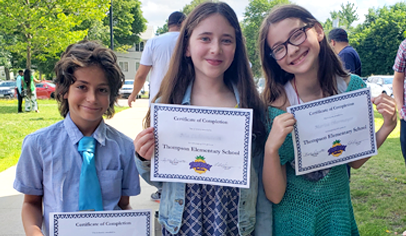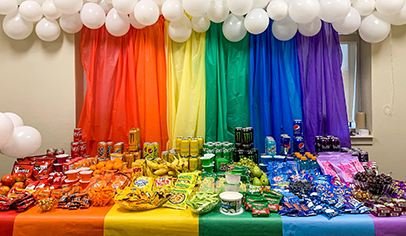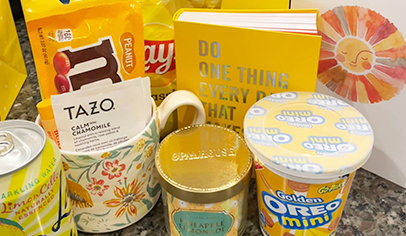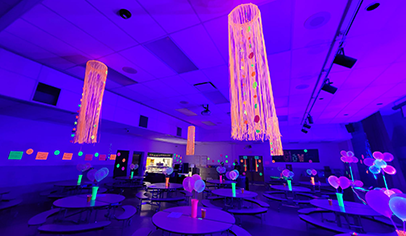Family fitness nights are about a lot more than fun and games. By holding a family fitness night, you can emphasize the importance of physical fitness, get kids interested in sports and active games, and help families connect with resources in their community.
A family fitness night or gym night is an evening of fun and physical activities for students and parents using your school’s equipment to stress the importance of staying healthy. “It’s a great way to expose kids to different activities and really let them see what a sport or activity is all about,” says Liz Adams, first vice president for programs with the Hendricks Avenue Elementary PTA in Jacksonville, Fla. “It’s a sports sampler.”
A gym night at Churchville Middle School in Elmhurst, Ill., gave parents an opportunity to have fun with their kids at school, something that can be rare in middle school. “It’s a very popular event,” says PTA president Liz Eder. “We received a lot of positive feedback and it gave the community an opportunity to come to the middle school, which doesn’t happen often.”
Another benefit of this type of fitness night is its relative low cost. By getting help from local businesses and community groups, PTOs can keep costs to a minimum. Here’s how to go about planning an event for your parent group.
Getting Started
Be sure to choose a location large enough to comfortably hold all the activities you want to include. A gymnasium or cafeteria usually works best. Consider combining your efforts with another school with larger facilities if yours aren’t big enough.
It’s best to hold your fitness program during a time when you won’t be competing with other events. Winter is a great time because the weather isn’t conducive to playing outdoors and it’s a down time for most sports. The beginning of a new calendar year might also gain you a few more attendees, since many folks will be making resolutions to live a healthier lifestyle. Or you could choose the month of May to tie your event into National Physical Fitness and Sports Month.
Not only do you need to determine how long your event should be; you also need to consider at what time it should be held. One to two hours should be an adequate amount of time for families to rotate through your activities. Early evening on a weeknight or late morning on a weekend generally works well, but you know your school community best, so plan accordingly.
Bring your physical education teacher on board early in the planning process. You’ll need her approval to use the school’s PE equipment. She will also be able to give feedback on what activities will interest students, and can help promote the event to students. “Parents typically don’t see the PE teacher at conferences or during open houses, so this is her time to shine,” says Christine Zona, president of the Townwide PTO of New Milford, Conn.
Don’t forget to gain approval through your principal or central office, filling out any necessary forms along the way.
Choosing Activities
Many schools that host fitness nights set up stations for different activities throughout the gym or school. At Hendricks Avenue Elementary, one station has a video game dance mat, another has bicycles, yet another an obstacle course, and so on. Here are some activities you may be able to do using equipment already at the school: basketball shoot-out; obstacle course relay (with bicycles or tricycles, if available); Hula-Hoop, limbo, or jump-rope contests; and wall climbing.
Up the fun factor by giving families a chance to try new activities. Ask instructors from a local gym or martial arts studio to give short lessons. Consider stations for aerobics, latin fitness dance, or line dancing; yoga or Pilates; karate or other martial arts; and kickboxing.
Work out a system for moving people through the stations and preventing long lines from forming. It’s best to keep things moving fairly quickly to keep children from becoming bored and disruptive while waiting their turn.
You may want to allow participants to wander through a series of short activities at their own pace. For stations where instructors lead participants in activities like yoga or dancing, set time limits and have a signal designating when it’s time to move to the next station. You could use a whistle or bullhorn, or ask a DJ to volunteer his services. A DJ can help keep energy high throughout the event and can hand out door and raffle prizes.
Get the Community Involved
In addition to physical activities, many schools tap their local communities to provide services such as free health screenings, chair massages, bike helmet fittings, bicycle safety demonstrations, CPR demonstrations, and body mass index readings. Organizations you might contact include the American Red Cross, the American Heart Association, local police and fire departments, dentists, doctors, or optometrists, and the county health department.
To acquire door prizes or raffle items, offer table space for sports clubs, aerobic instructors, local youth sports organizations, personal trainers, dance schools, gymnastic facilities, bicycle shops, martial arts instructors, and exercise equipment vendors.
You might also ask a local business to sponsor a craft booth where participants can create stress balls (fill an empty balloon with corn starch and tie securely—don’t use water balloons, they’re too thin) or water bottle weights (fill empty water bottles with small pebbles or sand). These will provide a “workout” of another sort and provide participants with a reminder of the event and what they learned.
Keep Food Healthy
Your family fitness night is a great opportunity to teach people about healthy snacks (read “Healthy Snack Ideas for PTO Events” for some suggestions). Provide bottled water (consider a custom label with your school logo), fresh fruits and vegetables, pretzels, granola bars, and unbuttered popcorn. You might want to sell refreshments to help cover costs. However, be sure to provide water coolers with disposable cups at no charge in various locations throughout your facility.
An event stressing the importance of healthy eating is also a great venue for allowing students to try unfamiliar foods by setting up a taste-test station. Various fresh fruits and vegetables, dried fruit, yogurt, trail mix, baked chips, and even whole-wheat pastas are easy to provide in small quantities.
Round Up Volunteers
Volunteers will ensure the success of your event. You’ll need two volunteers at each activity station. Limit volunteer time slots to no more than 45 minutes so that helpers can enjoy the evening with their families, too. Volunteer jobs include setting up, explaining station activities to participants, replenishing station supplies if needed, distributing refreshments, and keeping participants engaged.
Don’t limit your volunteers to just parents. Ask local high school or college athletes, teachers, coaches from local sports teams, Scout groups, and community leaders. Hendricks Avenue Elementary reports using physical education students from Jacksonville University, a recommendation from the PE teacher.
Gym Night Best Practices
-
Don’t go all out providing a great family fitness night only to turn around and offer door prizes for movie rentals or restaurant gift certificates. Instead, look for donations of sports equipment (helmets, elbow pads, shin guards, balls, and hand weights), free gym memberships, local health food store gift cards, and similar items.
-
Consider coming up with a fun theme and a logo that you can use from year to year. Use the theme to create giveaways such as sports bottles, sweat bands, or hats.
-
Don’t forget to take pictures for next year’s flyer, to provide to media, for the yearbook, and to post on the school and parent group websites.
-
If your PTO gets donations from businesses, make sure to thank them during and after the event.
Family Fitness Night Games
Freeze Dance
All participants stand on the dance floor. When the music begins, players dance. When the music is stopped at random times, the participants must freeze. Anyone still moving is out. The last participant standing wins.
Balloon Basketball
Blow up several balloons. Divide players into two equal teams and place the balloons between them. When indicated, teams are to run to the balloons, pick up one, and attempt to get it through the basketball hoop. Once the balloon is near the basket, it can be repeatedly hit to make a basket. Balloons can also be “rebounded” by the other team. Each basket is worth two points and the team with the highest score after the designated time is the winner. Tip: The more balloons you have, the more fun the game is.
Five Pin Soccer
Place teams several feet apart, such as on the opposite ends of a gym. Place five two-liter plastic soda bottles weighted with sand in the bottom, or bowling pins, in the center between the teams. When signaled to start, players kick balls from their line, attempting to knock down a pin. A player who knocks down the pin must run out and stand it back up. One point is scored for each pin knocked down. The first team to get five points wins.
Hula-Hoop Roll
Two teams stand in equal lines with the first child holding a Hula-Hoop. When indicated, the child holding the Hula-Hoop rolls it the length of the course and returns back to the line, handing the Hula-Hoop to the next child, who repeats the steps. The first team to have every participant run the length of the course with the Hula-Hoop wins.
Gym Scooter Bobsledding
Divide nine students into three equal teams. For each team, place three gym scooters in a vertical line and place a gym mat on top. Have two students sit on the front two scooters on top of the mat. The third student pushes the scooter bobsled from the last scooter. Set up cones that each team must navigate through. The first team to complete the course wins.















